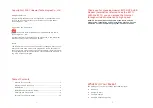
8 FAX
SSTV signals are often found in the band segment 3730-3740 kHz, as well as 14230 and
14240 kHz. After a short period of getting used to things, the sound of SSTV, as in all
other forms of picture transmission, is rapidly recognized by its distinctive sound from the
station loudspeaker.
8.3
FAX and SSTV with JVComm32
As with
WIN95
the real-time processing is not reliable enough,
JVComm32
also had
problems using the PTC SSTV/FAX transmission routine at slower PCs. For transmission
the PTC needs a continuous data stream with a high baud rate (usually 57600 baud) from
the PC´s serial interface. No interrupt should occur, as gaps and shifts within the
transmitted picture would be tht result. But a continuous data stream using
WIN95
is
only possible with very fast PCs – and also this is no guarantee – it depends on the
computing capacity occupied by other applications.
The second problem of the older implementation: The transmission timing must be
provided by the PC. But PCs only use inacurate and unadjusted oscillators so a relatively
complicated procedure for skew correction on the transmission side was necessary.
Both problems are solved with the new modem command
JVComm
within the
fax:-
menu,
activating a new transmission routine. On the receiving side the JVComm modem of the
PTC-IIex has the same behavior as the previous FMfax modem (also activated within the
fax:-
menu). The only difference is that the PTC provides no receiving data while the
JVComm modem of the PTC-IIex is in transmission state. That means that no full-duplex
with loop back is possible.
The JVComm transmission routine provides a buffered data exchange with handshake.
This dramaticly reduces the real-time requirements of Win95. The PTC transmits data
exactly with a rate of 1/20 * Mbaud rate on the HF side (DSP modem). Because the data
rate on account of the 10 steps/byte at the serial interface could be at a maximum 1/10 *
Mbaud rate, the PC has a lot of time to fill the transmission buffer of the PTC.
8.3.1
Specifications
PTC-data buffer size
over all: 13312 byte
Handshake
(RTS, PIN 8 at the SUB-D-9 socket of the PTC)
•
Activated (=XOFF, -10 V) at: 8000 byte or more in the buffer
•
Deactivated (=XON, +10 V) at: 6000 byte or less in the buffer
After XOFF the PC could still send about 5000 bytes without causing a buffer overflow.
Output data rate
: exactly 1/20 * Mbaud rate
A skew correction usually is not necessary because the PTC-IIex quartz is adjusted up to
some ppm.
98
Содержание PTC-IIex
Страница 14: ...List of Figures and Tables XII...
Страница 30: ...3 Installation 16...
Страница 108: ...7 Audio 94...
Страница 126: ...8 FAX 112...
Страница 173: ...12 SYStest 159...
Страница 183: ...14 Circuit Description 169...
Страница 195: ...15 Basics 181...
Страница 201: ...B Technical Data 187...
Страница 202: ...C Layout Appendix C 19 Layout B 1 Motherboard Figure B 1 Motherboard 188...
Страница 203: ...C Layout 189...
Страница 215: ...Index 202...















































